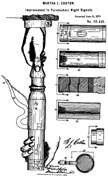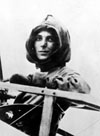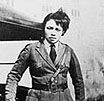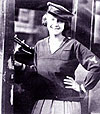1839
In Mississippi, the Married Woman's Property Act is passed, allowing married women to own property.

|
|

July 19-20, 1848
Seneca Falls Convention in New York marks the beginning of the women's equal rights movement. The "Declaration of Sentiments," is read by Elizabeth Cady Stanton.
|
|
1850
 Harriet Tubman, who escaped slavery in 1849, becomes a conductor on the Underground Railroad. She helps more than 300 slaves to freedom by 1858. Harriet Tubman, who escaped slavery in 1849, becomes a conductor on the Underground Railroad. She helps more than 300 slaves to freedom by 1858.
|
 1859 1859
Martha J. Coston is granted a patent for Telegraphic Night Signals, a pyrotechnic signaling system that revolutionizes maritime communication. The U.S. Navy used the system to win battles and rescue shipwreck victims.
[more about maritime navigation]
|
|
1861-1865
War between the States.
|
January 1, 1863
 President Lincoln issues the Emancipation Proclamation ending slavery President Lincoln issues the Emancipation Proclamation ending slavery
1868
14h Amendment grants citizenship to African Americans.

|
|
1870
15th Amendment grants African-American males the right to vote.

|
|
May 24, 1883
 Brooklyn Bridge opens. Emily Warren Roebling was the surrogate chief engineer from 1872 to 1883, supervising the day-to-day construction, after her husband, Washington Roebling, the Chief Engineer, became bedridden. Brooklyn Bridge opens. Emily Warren Roebling was the surrogate chief engineer from 1872 to 1883, supervising the day-to-day construction, after her husband, Washington Roebling, the Chief Engineer, became bedridden.
[more about bridge construction]
|
 November 14, 1889, 9:40 a.m.
November 14, 1889, 9:40 a.m.
 Journalist Elizabeth Cochrane Seaman, better known as Nellie Bly, begins her attempt to beat the record of Phineas Fogg, the imaginary hero of Jules Verne's novel, Around the World in Eighty Days. Nellie Bly completes her journey on January 25, 1890, 3:51 p.m., exactly 72 days, 6 hours, and 11 minutes from the day she began her trip. Journalist Elizabeth Cochrane Seaman, better known as Nellie Bly, begins her attempt to beat the record of Phineas Fogg, the imaginary hero of Jules Verne's novel, Around the World in Eighty Days. Nellie Bly completes her journey on January 25, 1890, 3:51 p.m., exactly 72 days, 6 hours, and 11 minutes from the day she began her trip.
|
|
February 8, 1891
New York City resident, Mary Walton, is granted a patent for her railroad sound-dampening apparatus, which laid the tracks in a wood box lined with cotton and filled with sand.
|
October 3, 1893
General Roy Stone opens the Office of Road Inquiry under the Department of Agriculture. This is the earliest predecessor of the Federal Highway Administration.
The first American horseless carriage, the Duryea was made in 1893.
|
|
|
August 1, 1911
 Harriet Quimby becomes the first female American licensed pilot. She is the first woman to fly across the English Channel on April 16, 1912. Harriet Quimby becomes the first female American licensed pilot. She is the first woman to fly across the English Channel on April 16, 1912.
[more about aviation pioneers]
1914-1918
World War I
|
|
1920
 Bessie Coleman, the first African-American female pilot, earns her license from the French Federation Aeronautique. Racial discrimination prevents her from learning to fly in the U.S. She later returns to the U.S., works as a "barnstormer" entertaining crowds with her flying, and promotes the concept of a flying school for African Americans. Bessie Coleman, the first African-American female pilot, earns her license from the French Federation Aeronautique. Racial discrimination prevents her from learning to fly in the U.S. She later returns to the U.S., works as a "barnstormer" entertaining crowds with her flying, and promotes the concept of a flying school for African Americans.
[more about aviation pioneers]
|
August 26, 1920
19th Amendment gives women the right to vote.

|
April 1922
 Helen Schultz, the "Iowa Bus Queen," establishes the Red Ball Transportation Company, providing city-to-city transportation by bus. Helen Schultz, the "Iowa Bus Queen," establishes the Red Ball Transportation Company, providing city-to-city transportation by bus.
[more about bus operators]
|
|
View 1930 to 2000 |